
(Shutterstock AI Image)
Artificial intelligence is quickly becoming embedded in the machinery of government. From defense and diplomacy to internal operations and citizen services, public institutions around the world are turning to advanced models to improve speed, scale, and decision-making.
While AI is being deployed across federal systems in the U.S. with remarkable urgency, it is ironic how the National Science Foundation (NSF), a key supporter of AI research, is being pushed out of its own headquarters.
One of the most significant signals of AI’s growing role in the U.S. public sector came last month, when the Department of Defense awarded OpenAI a contract worth up to $200 million. The deal will fund AI tools for administrative tasks, data analysis, and proactive cyber defense, with work expected to run through July 2026 in the Washington, D.C. area.
The Pentagon described the effort as a push to prototype “frontier AI capabilities” across both military use cases and enterprise domains, ranging from streamlining healthcare access for service members to improving how agencies manage program data.

(turtix/Shutterstock)
OpenAI says this marks its first official partnership under a new initiative to bring its models to all levels of government. Just a year ago, such a partnership would have been unlikely. OpenAI’s earlier terms of service prohibited military use, a restriction quietly removed in 2024. The contract reflects a broader shift, as other AI firms like Anthropic, Google, and Meta also move to align their technologies with U.S. national security goals.
“This contract, with a $200 million ceiling, will bring OpenAI’s industry-leading expertise to help the Defense Department identify and prototype how frontier AI can transform its administrative operations, from improving how service members and their families get health care, to streamlining how they look at program and acquisition data, to supporting proactive cyber defense,” OpenAI said.
Following closely on the heels of defense-focused contracts, Palantir and Accenture Federal Services have launched a sweeping initiative to modernize how U.S. federal agencies work with data. The effort centers on integrating Palantir’s AI-driven platforms into core government operations, with Accenture Federal designated as the lead implementation partner.
To support the rollout, Accenture plans to train 1,000 AI specialists capable of delivering scalable solutions inside federal systems. The first wave of offerings targets real-time data delivery to frontline workers, AI-enabled supply chain automation, and cross-agency financial intelligence.
Accenture Federal Services CEO Ron Ash emphasized the impact of the initiative, framing it as a major shift in how agencies operate. “This is a game changer for our federal customers,” he said, highlighting the benefits of integrating AI directly into daily government workflows.
That shift isn’t limited to tools and platforms; it’s starting to shape leadership as well. In June, the U.S. Army Reserve recently established Detachment 201, a new unit composed of civilian experts, including tech leaders from organizations such as OpenAI, Meta, and Palantir. The unit is designed to support the Department of Defense by contributing advanced AI and technology expertise to help address emerging operational and strategic challenges.

(SuPatMaN/Shutterstock)
According to a recent survey from the Public Sector HR Association, a growing number of state and local government employees are getting hands-on with AI in their daily work. More than 80% of state and local government workers have started using AI tools on the job. Many described the experience as straightforward and useful, especially for handling repetitive tasks.
The rising influence of AI in the public sector isn’t just a U.S. story. In the UK, AI is now underpinning patient safety protocols in the national health system. In India, state governments are appointing AI officers to guide digital transformation from within. And across the EU, strategic frameworks are pushing public agencies to integrate AI into everything from transportation to justice.
While headlines suggest AI is sweeping through government, the reality inside many agencies is more complicated. A recent EY survey captures the tension well: 64% of public sector leaders believe AI could be transformative, but only 26% say their organizations are truly ready to use it.
That disconnect isn’t just about having the right tools; it reflects deeper challenges like rigid structures, outdated infrastructure, and the slow-moving culture that often makes innovation in government harder than it looks. It’s a long road ahead for AI to make a lasting impact in the public sector.
However, that gap may prove to be a powerful motivator. With growing expectations from both leadership and the public, agencies are under pressure to follow through, not just with plans, but with real implementation. For the public sector, this could mark an inflection point in how AI is adopted and applied.

